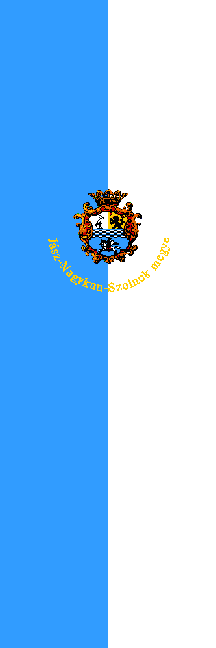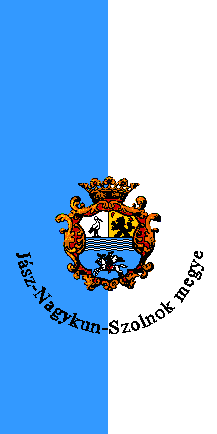Jasz-Nagykun-Szolnok County (Hungary) (original) (raw)

This page is part of © FOTW Flags Of The World website
Jász-Nagykum-Szolnok megye
Last modified: 2025-01-18 by zoltán horváth
Keywords: hungary | jasz-nagykun-szolnok | nagykun | szolnok | tisza | zagyva | koros |
Links: FOTW homepage |search | disclaimer and copyright | write us | mirrors
See also:
Municipalities (78 settlements, including 19 towns and 1 city):
City (not part of the county):
Towns:
- Abádszalók (since 2005)
- Besenyszög (since 2013)
- Fegyvernek (since 2013)
- Jászapáti (since 1989)
- Jászárokszállás (since 1991)
- Jászberény
- Jászfényszaru (since 1993)
- Jászkisér (since 2009)
- Karcag
- Kenderes (since 2004)
- Kisújszállás
- Kunhegyes (since 1989)
- Kunszentmárton (since 1986)
- Martfű (since 1989)
- Mezőtúr
- Rákóczifalva (since 2009)
- Tiszaföldvár (since 1993)
- Tiszafüred (since 1984)
- Törökszentmiklós (since 1952)
- Túrkeve
- Újszász (since 1997)
Other municipalities in FOTW:
Flag in Use

image by István Molnár, 27 August 2001
Flying flag at the Conquest Statue, Opusztaszer NHP. Ratio: 3:1. The width of the Coat of Arms is the 1/3 of the width of the flag. The Coat of Arms is on the 1/3 of the flag's height. The inscription is gold.
István Molnár, 27 August 2001
Coat of Arms

image from <www.externet.hu>, located by Pascal Vagnat, 29 December 1998
The Coat of Arms (bigger image) as well as an explanation (in Hungarian) of the Coat of Arms of Ja'sz-Nagykun-Szolnok county in Hungary at <www.externet.hu>.
Pascal Vagnat, 29 December 1998
This is the description:
Coat of Arms of Jasz-Nagykun-Szolnok brought back in 1991, with "renovations" to the Coat of Arms of 1878. The Chief is divided into two fields, the sinister side having a stork symbolizing Outer-Szolnok, the dexter side having a dark brown lion, above him a scarlet moon and star, symbolizing the Nagykunsag the bottom part of the Coat of Arms is a soldier riding a white horse, in his left hand a Lehel-kurt (a Hungarian legend taking place at the battle of Augsburg in 955 AD), in his left hand a shield the three white bands symbolize JNSz's three main rivers, the Tisza (Theiss), the Zagyva, and the Koros.
Georges Kovari III, 29 December 1998
